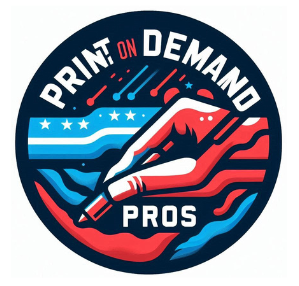Print On Demand (POD) is like the choose-your-own-adventure of the e-commerce world. You don’t need a big bankroll or a garage full of stuff to start. It’s a sweet deal: you just upload your designs, and when someone places an order, the product gets made and shipped straight to ‘em. No sweat!
Now, when it comes to products, think of all the cool merch you love: those snazzy T-shirts, hoodies, or even funky phone cases. POD lets you slap your designs on these and more like mugs, tote bags, and posters. You’re in full control without having to buy in bulk.
The best part about POD? Low startup costs. You don’t need a ton of cash to get rolling. Inventory? Nope, don’t even stress about it. Plus, the flexibility in customizing products means you can really let your creativity fly high. Growing your store can happen fast with cool ideas and designs rolling in.
But hey, keep it real with expectations. The flip side is, because you’re managing everything online, profit margins can be a bit tight. And you’re leaning on those third-party printers, so sometimes there might be shipping delays. It’s all about finding the right balance.
Think of POD like a playground for creators, small businesses, and entrepreneurs looking to get those unique, personalized items out into the world without playing the big inventory game.
Choosing the Right Platform: Evaluating Your Options
Picking the perfect platform for your POD store is like gearing up for a big adventure—you need the right tools! Each platform, whether it’s Shopify, Printful, Printify, Teespring, or Redbubble, offers something unique.
Shopify might charm you with its versatility and robust features, making it a solid choice if you’re dreaming of scaling up. Printful’s got your back with its seamless integration options and wide range of products, perfect for those who value ease and choice.
Printify will grab the eye of cost-conscious hustlers, offering a global network of printers to play with. Meanwhile, Teespring is cool if you’re all about getting creative with unique apparel designs without upfront costs. Redbubble’s community vibe is unbeatable, ideal for artists who love connecting with fellow creatives.
When it comes down to choosing, consider what fits your vibe and goals. Are you aiming for simplicity and low startup costs? Or are you ready to dive into something that offers scalability and more complexity?
To give you some real-world inspo, consider some success stories. Look at brands thriving on these platforms—they’re not just selling products; they’re building communities and turning their designs into movements.
Remember, this isn’t a one-size-fits-all. Take a closer look at the features, pricing, and community support. It’s your adventure, so pick the path that suits you best!

Creating Unique Products: The Art of Customization
Designing killer products is where your creativity gets to shine like a neon sign! Customization is your secret weapon in the POD game, and the possibilities are almost endless.
First up, you’ll wanna get friendly with design tools that make life easier. Canva, Adobe Illustrator, or even sites like Placeit are great for mocking up those designs that’ll have folks hitting ‘Add to Cart’ without a second thought.
Trends are your pals here. Peek at what’s getting folks excited—be it bold colors, sassy quotes, or retro vibes. Knowing what’s hot helps you keep your store fresh and on-point.
The magic happens when your designs talk directly to your customers’ hearts and minds. Think niche! Are you into vintage video games or glossy space art? Dive into those interests, and before you know it, you’re creating products that customers can’t resist.
Streamlining your process will save sanity points down the road. Set up a design routine, batch create, and keep your files organized. Uploading them to your platform should be a breeze if you’ve got a system in place, making the path from brainstorm to product page smooth as butter.
Streamlining Operations: From Order to Delivery
So, how does your stuff get from your online store to your customer’s doorstep without you lifting a finger? That’s where the genius of POD fulfillment comes into play. The process involves automation and efficiency, making your life as easy as pie.
When an order pops up on your store, the POD provider jumps into action, handling the printing, packing, and shipping like a pro. This hands-off approach means you can focus on what you do best—creating and marketing.
Still, it’s important to know the ins and outs of your chosen POD provider’s logistics. Some might have a faster turnaround, while others rock at keeping quality consistent. Compare these aspects to find a partner that matches your business vibe.
Occasionally, shipping delays might creep in. It’s crucial to communicate with your customers clearly if things take a little longer. Most buyers appreciate honesty and transparency, so keep those lines open!
Each POD player offers different fulfilment models. Some excel in local shipping while others shine globally. Depending on where your audience chills, make sure your provider can reach them without a hitch. Taking the time to understand these details upfront can save headaches down the road.
 Marketing Your POD Store: From Zero to Visibility
Marketing Your POD Store: From Zero to Visibility
In the bustling world of e-commerce, getting your POD store noticed requires a mix of savvy strategies and a pinch of creativity. Building a standout brand identity is your first move—think logo, color scheme, and a vibe that screams ‘you’.
Social media is your megaphone. Platforms like Instagram, Facebook, and Pinterest are goldmines for showcasing your products. Regular, engaging posts can attract attention and keep your audience hooked. Don’t shy away from using eye-catching photos or behind-the-scenes glimpses to build a connection with your potential customers.
SEO might sound a little nerdy, but it’s your ticket to appearing in search results. Keyword research is your best friend here, ensuring your product descriptions and blog content rank well. Pop those targeted keywords into your shop pages too, so when someone’s on the hunt for cool T-shirts or tote bags, they find you first.
Partnering with influencers can give your store that extra push, lending you their audience’s trust and broadening your reach. It’s like a shoutout from a friend in a crowded room, getting new folks to say, ‘whoa, what’s that?’.
Email marketing still holds its weight, offering a direct line to your customers. Regular newsletters filled with updates, special offers, or even a quirky story about your latest design can keep subscribers engaged and eager for more. Plus, it’s a nice way to reward loyal fans with exclusive deals.
Getting all these strategies working together ensures your POD store doesn’t just sit in the background. It becomes a brand that folks remember and return to time and again.


Setting up your own Print On Demand shop, is the dream of many creative people that want to see their own designs in print. To set up a POD is actually easier than expected. With the variety of options like Shopify, Printify and Printful, that cater for different needs and markets, one can be spoilt for choice.
Using social media for marketing, makes it easy to reach your target audience. Teaming up with influencers, can further grow your reach. All the best in setting up your own POD.
Setting up an online print-on-demand store is a fantastic way to tap into the growing e-commerce market. The article provides a comprehensive guide that is both informative and easy to follow. I found the section on choosing the right niche particularly insightful. It’s crucial to identify a target audience and cater to their specific needs to stand out in a competitive market. This approach not only helps in creating a unique brand identity but also ensures that the products offered resonate well with potential customers.
Additionally, the tips on integrating with e-commerce platforms like Shopify and WooCommerce are invaluable for streamlining operations and enhancing customer experience. These platforms offer a range of tools and features that can simplify the process of setting up and managing an online store, from inventory management to payment processing. The article also highlights the importance of marketing strategies, such as social media promotion and search engine optimization, which are essential for driving traffic to the store and increasing sales.
Moreover, the emphasis on quality control and customer service is commendable. Ensuring that products meet high standards and addressing customer inquiries promptly can significantly impact the success of an online store. Overall, this guide is an excellent resource for anyone looking to venture into the print-on-demand business, providing practical advice and actionable steps to help entrepreneurs succeed in the competitive world of e-commerce.